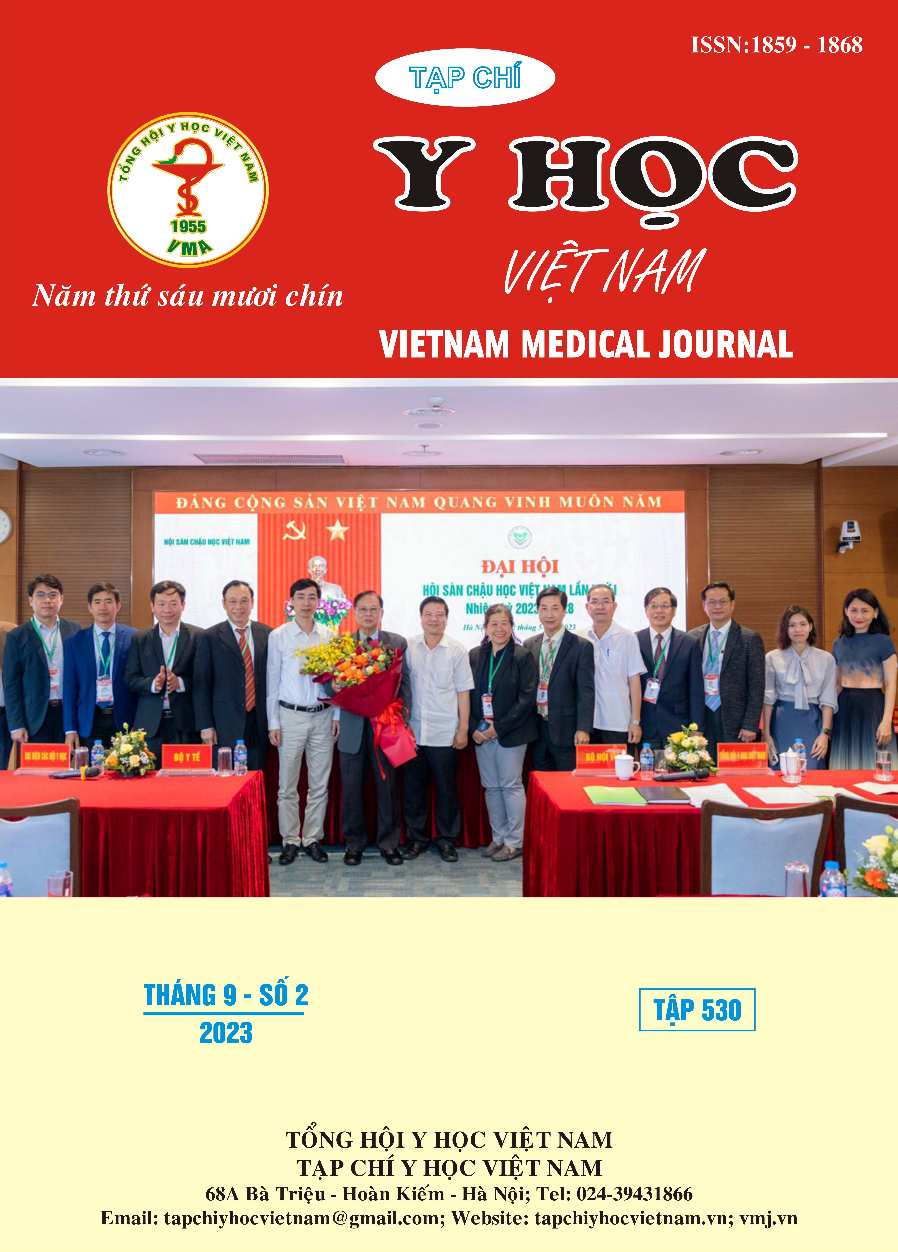EVALUATING THE EFFECTIVENESS OF UTERINE FIBROID EMBOLIZATION WITH MICROSPHERES COAXIAL
Main Article Content
Abstract
Objective: To evaluate the results of effective treatment of uterine leiomyoma tumours with coaxial seeds from 01/2021 to 06/2023. Subjects and methods: Prospective study combining retrospective treatment of cases of uterine leiomyoma embolization with coaxial granules from 01/2021 to 06/2023. Results: 50 patients met the criteria for inclusion in the study, the average age was 41.0 ± 5.6 (24 – 53)years old, the reason for admission was mainly due to menorrhagia (64%). The mean diameter (mm) of the largest tumor: 76,8 ± 23,5 (44 - 150) and the mean weight (gram) of the largest tumor: 209,5 ± 200.0 (35,0 - 997,9). 88% of patients were used with embolization beads with the size of 500 - 900μm, with 78% of patients having increased angiogenesis from 2 uterine arteries and 92% of patients having strong angiogenesis with the intervention time 91.4 ± 40.6 (45 - 240). minute). 1 patient needed a second embolization after 14 months of intervention. 100% of patients were free of anemia and urinary disorders, there was no difference in clinical effectiveness and tumor size reduction between the group with the largest tumor diameter < 10 cm and > 10 cm. Complications of fever and persistent abdominal pain were higher in the group with the largest tumor diameter > 10 cm. Conclusion: The technique of treating uterine leiomyoma tumor with coaxial granules is a safe and highly effective technique.
Objective: To evaluate the results of effective treatment of uterine leiomyoma tumours with coaxial seeds from 01/2021 to 06/2023. Subjects and methods: Prospective study combining retrospective treatment of cases of uterine leiomyoma embolization with coaxial granules from 01/2021 to 06/2023. Results: 50 patients met the criteria for inclusion in the study, the average age was 41.0 ± 5.6 (24 – 53)years old, the reason for admission was mainly due to menorrhagia (64%). The mean diameter (mm) of the largest tumor: 76,8 ± 23,5 (44 - 150) and the mean weight (gram) of the largest tumor: 209,5 ± 200.0 (35,0 - 997,9). 88% of patients were used with embolization beads with the size of 500 - 900μm, with 78% of patients having increased angiogenesis from 2 uterine arteries and 92% of patients having strong angiogenesis with the intervention time 91.4 ± 40.6 (45 - 240). minute). 1 patient needed a second embolization after 14 months of intervention. 100% of patients were free of anemia and urinary disorders, there was no difference in clinical effectiveness and tumor size reduction between the group with the largest tumor diameter < 10 cm and > 10 cm. Complications of fever and persistent abdominal pain were higher in the group with the largest tumor diameter > 10 cm. Conclusion: The technique of treating uterine leiomyoma tumor with coaxial granules is a safe and highly effective technique.
Article Details
Keywords
Fibroma uterin; uterine artery embolization hay uterine fibroid embolization;…
References
2. Kim JJ, Sefton EC. The role of progesterone signaling in the pathogenesis of uterine leiomyoma. Mol Cell Endocrinol. 2012;358(2):223-231. doi:10.1016/j.mce.2011.05.044
3. Duhan N. Current and emerging treatments for uterine myoma – an update. Int J Womens Health. 2011;3:231-241. doi: 10.2147/ IJWH.S15710
4. Sue W, Sarah SB. Radiological appearances of uterine fibroids. Indian J Radiol Imaging. 2009; 19(3): 222-231. doi: 10.4103/ 0971-3026. 54887
5. Chaparala RPC, Fawole AS, Ambrose NS, Chapman AH. Large bowel obstruction due to a benign uterine leiomyoma. Gut. 2004;53(3):386. doi:10.1136/gut.2003.028134
6. Tang S, Kong M, Zhao X, et al. A systematic review and meta-analysis of the safety and efficacy of uterine artery embolization vs. surgery for symptomatic uterine fibroids. J Interv Med. 2019; 1(2):112-120. doi:10.19779/j.cnki.2096-3602.2018.02.10
7. Bulun SE. Uterine fibroids. N Engl J Med. 2013;369(14):1344-1355. doi:10.1056/NEJMra1209993
8. Greenwood LH, Glickman MG, Schwartz PE, Morse SS, Denny DF. Obstetric and nonmalignant gynecologic bleeding: treatment with angiographic embolization. Radiology. 1987;164(1):155-159. doi:10.1148/radiology.164.1.3495816
9. Goodwin SC, Vedantham S, McLucas B, Forno AE, Perrella R. Preliminary experience with uterine artery embolization for uterine fibroids. J Vasc Interv Radiol JVIR. 1997;8(4):517-526. doi:10.1016/s1051-0443(97)70603-1
10. Vo NJ, Andrews RT. Uterine Artery Embolization: A Safe and Effective, Minimally Invasive, Uterine-Sparing Treatment Option for Symptomatic Fibroids. Semin Interv Radiol. 2008; 25(3): 252-260. doi: 10.1055/ s-0028-1085923


